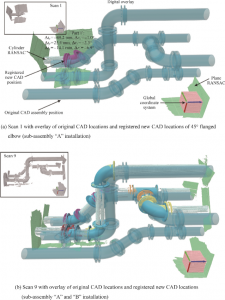From blueprint to reality: advanced 3D scanning ensures precision in assembly
GA, UNITED STATES, September 9, 2024 /EINPresswire.com/ -- Pioneering research has introduced a groundbreaking pipeline modeling technique using interval scanning point clouds, dramatically boosting the precision of manufacturing and construction. This advanced technology enables real-time detection of assembly deviations, ensuring alignment with original designs and minimizing the need for expensive rework.
Pipeline installations are often plagued by challenges such as design deviations and unexpected clashes during assembly, leading to costly corrections and project delays. Conventional quality control measures are usually implemented after fabrication, missing the opportunity for early error detection. This situation underscores the urgent need for integrated methods that provide continuous, real-time quality control throughout the entire assembly process.
Researchers from the University of Edinburgh, in a study (DOI: 10.1007/s40436-024-00515-y) published on August 7, 2024 in Advances in Manufacturing, have integrated three-dimensional (3D) scanning technology with computer aided design (CAD) models to track and monitor pipeline assembly progress. By comparing real-time scans with as-designed models, this approach empowers operators to spot potential issues early, preventing them from escalating into major problems. The study’s findings, validated using both real-world and synthetic datasets, demonstrate the effectiveness of this innovative approach.
The research presents a novel system that merges 3D scanning with CAD models to enhance quality control during pipeline assembly. The process leverages unorganised point clouds from 3D scans to detect deviations and component clashes early in the installation phase. A deep learning model, trained on synthetic datasets that replicate real-life conditions, classifies pipeline components with high accuracy, allowing for the precise identification of misalignments. This approach was tested on a downscaled prototype, showcasing how automated classification and CAD comparisons significantly reduce manual inspections and error rates. By providing real-time feedback, the system enables operators to address issues immediately, cutting down on rework and improving overall assembly efficiency. This seamless integration automates quality control, ensuring that critical deviations are detected early.
Dr. Nan Yu, Senior Lecturer in Digital Manufacture at the University of Edinburgh, emphasized the impact of this technology: "This approach represents a significant step forward in pipeline installation and quality control. By leveraging the latest in 3D scanning and AI technologies, we can detect errors before they become critical, saving time and resources in the assembly process."
The study's implications extend across industries that rely on complex pipeline installations, including oil, gas, and shipbuilding. By facilitating early detection of deviations and potential clashes, the method not only minimizes costly rework but also enhances overall assembly efficiency. This technology can serve as a valuable addition to current quality control protocols, seamlessly integrating into existing manufacturing workflows to improve productivity, reduce downtime, and ensure the accuracy of complex installations.
DOI
10.1007/s40436-024-00515-y
Original Source URL
https://doi.org/10.1007/s40436-024-00515-y
Funding information
This research was founded by Scottish Research Partnership in Engineering (SRPe), the National Manufacturing Institute Scotland (NMIS), ShapeSpace Ltd (Grant No. SFC-NMIS-IDP/020), and State Key Laboratory of Robotics and System (Grant No. SKLRS/2022/ KF/01).
Lucy Wang
BioDesign Research
email us here
Legal Disclaimer:
EIN Presswire provides this news content "as is" without warranty of any kind. We do not accept any responsibility or liability for the accuracy, content, images, videos, licenses, completeness, legality, or reliability of the information contained in this article. If you have any complaints or copyright issues related to this article, kindly contact the author above.

